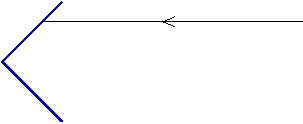Physics 8: Homework 8 Additional Questions
In addition to the problems from the book (14.E.3, 14.E.8, 14.E.10,
14.E.11, 14.E.12), here are more problems that are a required part
of the assignment:
- A retro-reflector, or corner-cube, returns light back in the same
direction from which it came. These are used in bike reflectors, for
instance. A two-dimensional corner-cube is drawn below, consisting of two
mirrors at right angles. Complete the drawing of the ray path. Note in
your answer how
the final ray direction compares to the initial (drawn) ray direction. If
you're ambitious (not required), you can convince yourself that this
property holds no matter what the direction of the incoming ray (other than
just horizontal, as shown).

- Can a fish see clearly when it jumps out of the water? Why or why
not?
- Episode II: Attack of the Angler In a pond far, far
away, a technologically advanced fisherman—let's call him
Fishbacca—takes aim at a fish a few feet underwater with his laser
gun. Should Fishbacca aim high, low, or right at the image of the fish?
Explain why and draw a picture.
- Episode III: Revenge of the Fish Unfortunately for
Fishbacca, this is no ordinary fish, but Darth Ictheous, whose signature
weapon is a formidable spear. Fishbacca fails to hit Darth Ictheous
(either the sinister fish evaded the laser blast or Fishbacca misunderstood
the physics of refraction), and now prepares to hurl his spear back at
Fishbacca, who is standing on the bank of the pond. Should Darth Ictheous
aim high, low, or right at the image of Fishbacca? Explain why and draw a picture.
- When light hits a surface where the refractive index changes, some of
the light is transmitted and some is reflected. The formula for reflection
is: R = [(n2 -
n1)/(n2 + n1)]2.
Calculate the amount of reflection at the following interfaces, using the
fact that the refractive indices of air, water, glass, and diamond are
1.00, 1.33, 1.52, and 2.42, respectively. Express your answers as percent reflection.
- air - water
- air - glass
- water - glass
- air - diamond
Note that this quantitatively explains why raindrops on the sidewalk look
dark: the air-sidewalk interface (much like air-glass, refractively) is roughly
ten times more reflective than the water-sidewalk interface.
- Explain why ice without air bubbles is clear, but ice riddled with lots
of tiny air bubbles looks white.
- Given what you know about why the sky is blue, explain why the sun
looks slightly yellow-ish, and why as the sun sets it gets more orange and
perhaps even red. A relevant question to ask yourself: how much air do the
rays from the sun have to traverse?
- In principle, if your eyes were sensitive enough, could you see a
moonbow—a rainbow with the moon rather than the sun as a source? In
which direction (relative to the moon) would you have to look?

